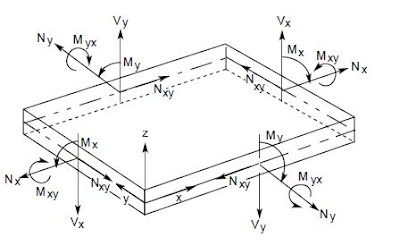stressebookllc
Aerospace
Dear Friends,
Most of us are familiar with the membrane forces and shell element moments which are element forces and moments written out as running loads and moments to the output file (.f06 or .out files depending on the flavor of Nastran)

General notation is NX NY NXY (membrane forces), MX MY (bending moments) MXY (twisting moments), and QX QY (transverse shear forces). I built a simple model, its a plate, constrained and loaded it with some loads that would give me most of these values in the output file. Model is attached.
The mesh is 0.5" square elements. I am able compare the element forces in the output file for element ID 29 for example, with the FBD of this element in FEMAP. I get pretty good correlation for all the forces.
For example, for element 29, I can add the FBD loads at two nodes 46 and 50 along Y, sum them, divide the sum with the edge length of 0.5" and I get my NY load per unit length on that side which is balanced on the other side, same with all forces including transverse shear forces QX and QY all check out OK.


But I am not sure if I am able to do the same with the moments. Can anyone explain to me how you would go about this for the moments?

Technically we should be able to look at the FBD moments in FEMAP for that element 29, and correlate them with the results in the output file similar to the forces as I explained above.
Stressing Stresslessly!
Most of us are familiar with the membrane forces and shell element moments which are element forces and moments written out as running loads and moments to the output file (.f06 or .out files depending on the flavor of Nastran)

General notation is NX NY NXY (membrane forces), MX MY (bending moments) MXY (twisting moments), and QX QY (transverse shear forces). I built a simple model, its a plate, constrained and loaded it with some loads that would give me most of these values in the output file. Model is attached.
The mesh is 0.5" square elements. I am able compare the element forces in the output file for element ID 29 for example, with the FBD of this element in FEMAP. I get pretty good correlation for all the forces.
For example, for element 29, I can add the FBD loads at two nodes 46 and 50 along Y, sum them, divide the sum with the edge length of 0.5" and I get my NY load per unit length on that side which is balanced on the other side, same with all forces including transverse shear forces QX and QY all check out OK.


But I am not sure if I am able to do the same with the moments. Can anyone explain to me how you would go about this for the moments?

Technically we should be able to look at the FBD moments in FEMAP for that element 29, and correlate them with the results in the output file similar to the forces as I explained above.
Stressing Stresslessly!

![[banghead] [banghead] [banghead]](/data/assets/smilies/banghead.gif)